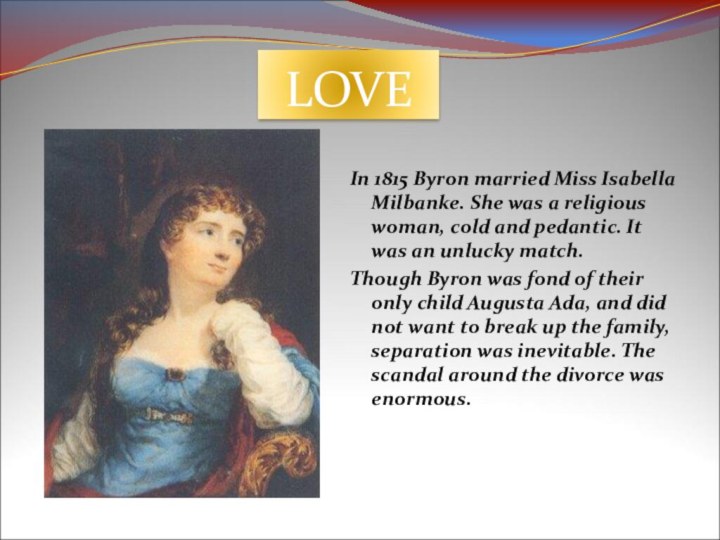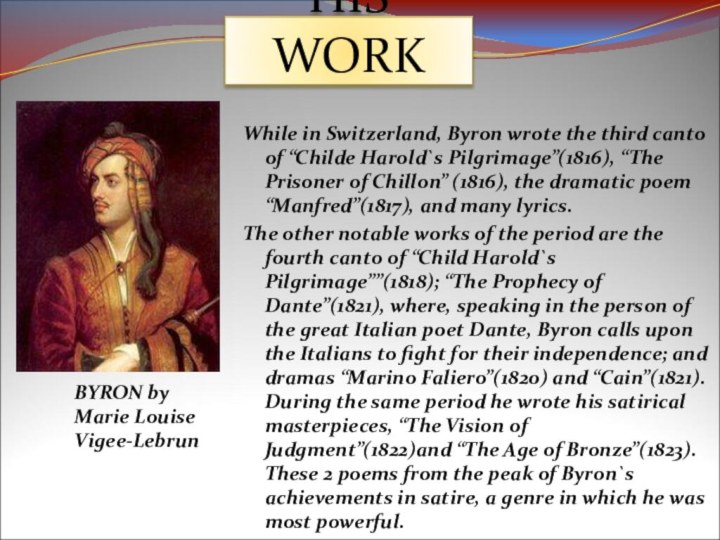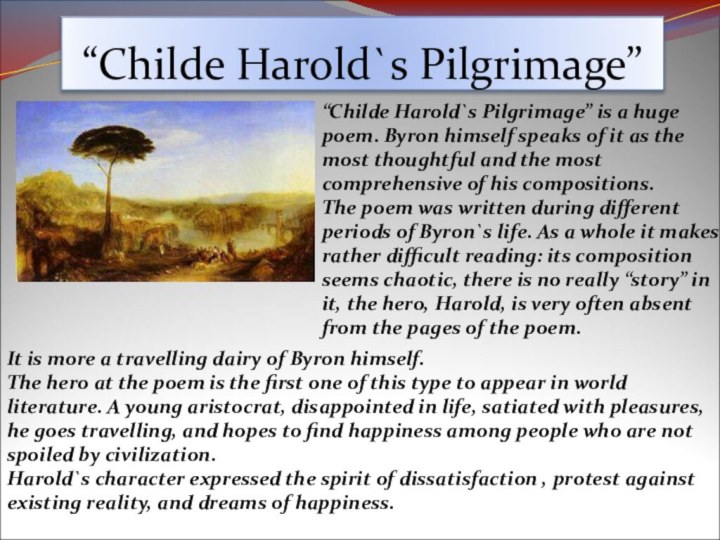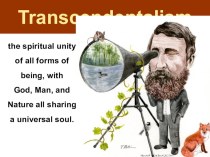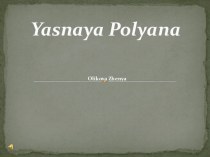Слайд 2
George Gordon BYRON
“…He who loves not his country,
can love nothing…”
Byron
“…I will teach, if possible, the stones
to rise against earth`s tyrants…”
From “Don Juan”
“And I will war, at least in words, with all who war
With Thought; and of Thought`s foes by far most rude,
Tyrants and sycophants have been and are…”
From “Don Juan”
Слайд 3
The poet was a real fighter; he struggled
against despotism with both pen and sword. Freedom was
the cause that he served all his life.
Like all the romantic writers of his time, Byron was disappointed with the results of the French Revolution; but unlike the Lake Poets who condemned their former beliefs and tried to escape from reality into the world of dreams and mysticism, he remained true to the ideas of
Liberty and equality. Byron hated wars and the rising power of capital. He sympathized with the oppressed people and seemed to understand their role in the future battles for freedom.
However, definite limitations of the poet`s world outlook caused deep contradictions on his works . Though Byron believed in the final triumph of good over evil, he could not foretell the paths the class struggle would take in the future, and many of his verses are touched with disappointed and scepticism . The philosophy of “world sorrow” becomes the leading theme of his works.
Слайд 4
The poet`s attention is drawn to the individual
and he dwells on the valour of the, romantic
hero, fighting for his own personal liberty.
Romantic individualism and a pessimistic attitude to life combine in Byron`s art with his firm belief in reason: realistic tendencies prevail in his works of the later period.
In spite of his pessimism, Byron`s verse embodies the aspirations of the English workers, Irish peasants, Spanish partisans, Italian Carbonary, Albanian and Greek patriots, and encouraged the struggle against the social evils of the time.
Byron`s flaming characters, his beautiful pictures of nature and his brilliant satirical power, coupled with his rich and melodious verse, appeal to us and, no doubt, will be admired by many generations to come.
Слайд 5
HIS CHILDHOOD
George Gordon Byron was born in London,
on January 22, 1788, in an impoverished aristocratic family.
His mother, Catherine Gordon, was a Scottish lady of honorable birth, and respectable fortune, his father, an army officer, died when the future poet was only 3 years old.
George was very lonely from early childhood. His mother was a woman of quick feelings and strong passions. Now she kissed him, now she scolded him. In one of her fits of passion she called him “a lame brat”, and the boy could not bring himself to forgive her this insult.
Слайд 6
EDUCATION
George was lame from birth and was sensitive
about it all his life, thanks to his strong
and regular training, he became an excellent rider, a champion swimmer, a boxer and took part in athletic exercises.
Byron spent the first 10 years of his life in
Scotland. He was found of the
rocky coast and mountains of the
country. He attended grammar school
in Aberdeen. The boy ‘devoured” books
of travel. These books greatly influenced
his poetical development.
In 1798 George`s grand-uncle died and
the boy inherited the title of baron.
Together with his mother and nurse the boy
moved to Newstead, from where
he was sent to Harrow School.
Слайд 7
of
Harrow School
Byron`s house in Newstead
Слайд 8
At the age of seventeen he entered Cambridge
University.
Слайд 9
EDUCATION
While a study, Byron published his first
collection of poems “Hours of Idleness”(1807). It was mercilessly
attacked by a well-known critic in the magazine “Edinburgh Review”. Wounded to the quick, Byron decided to take his revenge; a whole year was spent in preparation of a reply, which was published in 1809 under the title of “English Bards and Scotch Reviewers”. In this satirical poem, which is really criticism in verse, Byron makes a wide survey of contemporary literary life.
In the spring of 1808 Byron graduated from the University and received his M. A. (Master of Arts) degree, and next year took his hereditary seat in the House of Lords.
Слайд 10
LOVE
George was sixteen when he fell in love
with his distant relative Mary Chaworth, the ideal of
womanly perfection for him. She did not return his affection. But the memory of his first love clung to Byron throughout his life, and colored much of his writing.
In the first canto of “Childe Harold`s Pilgrimage” the poet says that Mary was the one whom he really loved..
Слайд 11
LOVE
In 1815 Byron married Miss Isabella Milbanke. She
was a religious woman, cold and pedantic. It was
an unlucky match.
Though Byron was fond of their only child Augusta Ada, and did not want to break up the family, separation was inevitable. The scandal around the divorce was enormous.
Слайд 12
TRAVEL
In 1809 he left England on a long
journey, which took 2 years. He visited Portugal, Spain,
Albania, Greece, and Turkey, and during his travels wrote the first 2 cantos of “Childe Harold`s Pilgrimage”. After an absence of 2 years the poet returned to England.
In 1817 Byron left for Italy. He visited Venice, Ravenna, Pisa, and Genoa. The political situation in Italy at this period was such as to rouse his indignation.
The Italian period(1817-1823), influenced revolutionary ideas, may be considered to be the summit of Hyron`s poetical career. Such works as “Beppo”(1818), a humorous poem in a Venetian setting and his greatest work “Don Juan” are the most realistic works written by the poet.
Слайд 13
AT THE AGE OF 36..
The defeat of the
Carbonari uprising(1822) was a heavy blow to Byron. The
war of Greece against the Turks, which had been going on for 2 years, attracted his attention. Byron longed for action, and went to Greece to take part in the struggle for national independence. Soon after his arrival he was seized
With fever and died at Missolonghi on the 18th of April, 1824, at the age of 36. The Greeks desired that his remains should be buried in the country which he had loved not less than his own, but his friends wanted him to be buried in Westminster Abbey.
Слайд 14
Westminster Abbey
However, this was refused by the English
authorities, and the poet`s body, already transported from Greece
to England, was buried in the family vault near Newstead.
Слайд 15
BYRON lying on deathbed by Joseph-Dinis Odevaere
Слайд 16
HIS WORK
On February 27,1812, Byron made his first
speech in House of Lords. He spoke passionately in
defense of the English proletariat and blamed the government for the unbearable conditions of the life of the workers.
In 1812 the first 2 cantos of “Childe Harold`s Pilgrimage” were published. They were received with a burst of enthusiasm by his contemporaries and Byron became one of the most popular men in London.
Between 1813 and 1816 Byron composed his “Oriental Tales”.
“The Giaour”, “The Corsair”, “Lara” and others. These tales embody the poet`s romantic individualism.
Слайд 18
HIS WORK
The hero of each poem is a
rebel against society. He is a man of strong
will and passion. Proud and independent, he rises against tyranny and injustice to gain his personal freedom and happiness. His revolt, however, is too individualistic, and therefore it is doomed to failure.
These romantic poems were admired by Byron`s contemporaries and called forth a new mode of thought called “Byronism”. They also gaverise to a new hero, a hero solitary and gloomy, involved in a single-handed struggle against oppression.
Слайд 19
HIS WORK
While in Switzerland, Byron wrote the third
canto of “Childe Harold`s Pilgrimage”(1816), “The Prisoner of Chillon”
(1816), the dramatic poem “Manfred”(1817), and many lyrics.
The other notable works of the period are the fourth canto of “Child Harold`s Pilgrimage””(1818); “The Prophecy of Dante”(1821), where, speaking in the person of the great Italian poet Dante, Byron calls upon the Italians to fight for their independence; and dramas “Marino Faliero”(1820) and “Cain”(1821). During the same period he wrote his satirical masterpieces, “The Vision of Judgment”(1822)and “The Age of Bronze”(1823). These 2 poems from the peak of Byron`s achievements in satire, a genre in which he was most powerful.
BYRON by Marie Louise Vigee-Lebrun
Слайд 20
“THE CORSAIR”
“The Corsair”(1814) has all the features typical

of Byron`s early romantic poems. It consists of disconnected
episodes, and the reader has to use his imagination in order to supply the parts.
The struggle between Conrad, a pirate, and Seyd, the Turkish Pasha, motivates the plot of the poem, but the main interest lies in character of Conrad. Thomas Macaulay defined a hero of this type as “a man proud, moody, cynical, with defiance of his brow, and misery in his heart, a scorner of his kind, implacable in revenge. Other characters, including, the gentle Medora, and the fiery-tempered slave-girl Gulnare are touched upon slightly.
In describing Conrad, Byron puts forth a concept of human character popular among the Progressive Romanticists; at time when bourgeois way of life, the romanticists saw great value in men whose souls were ruled by some strong passion. The capacity to experience an intense emotion was looked upon as a meansof protest against the hateful, everyday life.
Слайд 21
“Childe Harold`s Pilgrimage”
“Childe Harold`s Pilgrimage” is a huge
poem. Byron himself speaks of it as the most
thoughtful and the most comprehensive of his compositions.
The poem was written during different periods of Byron`s life. As a whole it makes rather difficult reading: its composition seems chaotic, there is no really “story” in it, the hero, Harold, is very often absent from the pages of the poem.
It is more a travelling dairy of Byron himself.
The hero at the poem is the first one of this type to appear in world literature. A young aristocrat, disappointed in life, satiated with pleasures, he goes travelling, and hopes to find happiness among people who are not spoiled by civilization.
Harold`s character expressed the spirit of dissatisfaction , protest against existing reality, and dreams of happiness.
Слайд 22
The first canto shows Portugal and Spain. In

the Spanish scenes the poet shows the struggle of
the people against Napoleon`s invasion which the poet witnessed during the journey in Spain in 1809-1810. Byron sympathizes with the Spanish people who where fighting for their freedom and independence and blames the ruling classes, who betray the interests of the country.
The second canto is devoted to Albania and Greece. Byron describes his own adventures in the country. He admires the Albanians for their kindness, generosity and hospitality.
Deep love for the Greeks and concern for their fate sound in the poet`s passionate appeal to the people to rise in arms against the oppressors.
Fair Greece! Sad relic of departed worth!
Immortal, though no more; though fallen, great!
Who now shall lead thy scatter`d children forth,
And long accustomed bondage uncreate?
Not such try sons who whilome did await,
The hopeless warriors of a willing doom,
In bleak Thermopyle`s sepulchral strait-
Oh, who that gallant spirit shall resume,
Leap from Eurotas banks, and call thee from the tomb?
Слайд 24
The third canto begins and ends with the
touching address of Byron to his daughter Ada, whom
he was never destined to see again.
My daughter! With thy name this song begun-
My daughter! With thy name thus much shall end-
I see thee not, I hear thee not, - but none
Can be so wrapt in thee;…
The political and biographical sketches which the third canto contains show greater maturity in the poet`s outlook.
The fourth canto, witch has to do with Italy, is usually regarded as the Finest. It describes people and events in ancient Italian history. Byron regrets the fall of the free states, their high cultur and art
I stood in Venice, on the Bridge of Sighs;
A palace and a prison on each hand:
I saw from out the wave her structure rise
As from the stroke of the enchanter`s wand: A thousand years their cloudy wings expand
Around me. And a dying glory smiles…
Byron calls Italy the “Mother of Arts”. He hopes that the former glory of the country can be taken as a pledge of her future prosperity.
Слайд 25
A great part of the forth canto is
dedicated to the theme of genius and immortality. Byron
puts forth the idea that true glory is achieved by creative activity, and not by illustrious birth and power.
Byron exposes the reactionaries of the time and expresses his belief in the final victory of the Italian people in their struggle for liberty.
The merit of “Child Harold`s Pilgrimage” is in its revolutionary spirit, in its board critical survey of contemporary life and vivid pictures of nature, now peaceful and calm, now stormy and violent, that mirror the poet`s own turbulent feelings.
“Childe Harold`s Pilgrimage” is really a philosophical treatise on the nature of wars, and Byron leads us to the conclusion that only wars fought for national or social liberation can be called just and praise worthy.










